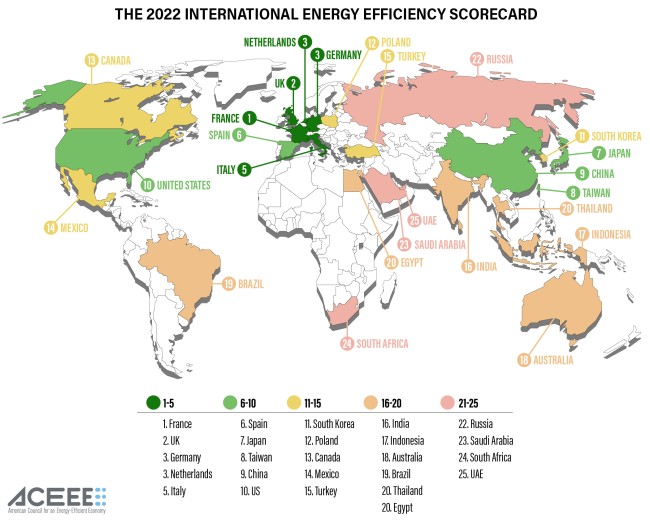France ranks #1, Netherlands moves up to #3, and U.S. remains at #10
Washington, DC—Despite an intensifying climate crisis and global uncertainty in energy markets, the world’s largest energy-using countries are making only limited progress in reducing energy waste and planet-warming emissions, according to the 2022 International Energy Efficiency Scorecard, published today by the nonprofit American Council for an Energy-Efficient Economy (ACEEE). To meet their climate goals, the report says, countries will need to rapidly scale their efficiency efforts.
International Symposium on Energy Efficiency
No country came close to a perfect score, and the average—48.5 out of 100—dipped slightly since the last scorecard in 2018. Yet some countries are taking bold steps such as increasing sales of electric vehicles (EVs) and adopting building performance standards, which require inefficient buildings to make energy-saving upgrades. France is a fine example, taking the top spot for the first time with 74.5 points. It’s closely followed by the United Kingdom (72.5 points), Germany and the Netherlands (each with 71.5), and Italy (68.5).
This fifth edition of the International Scorecard comes as Russia’s invasion of Ukraine has unsettled energy markets and increased prices and just a few months after many countries committed to deeper emissions cuts at a UN conference (COP 26) last year. It ranks 25 of the world’s largest energy users on 36 efficiency metrics and highlights best practices all countries can use to boost energy savings.
“Countries need energy efficiency now more than ever, especially as climate impacts worsen and gas prices soar,” said Steve Nadel, report coauthor and ACEEE’s executive director. “Efficiency can halve energy use and emissions while reducing dependence on foreign oil and pain at the pump,” he said, adding it’s often the least expensive way to meet the world’s growing demand for energy.
The scorecard evaluates countries accounting for 82% of energy consumed on the planet. It scores them on policy measures, such as fuel economy standards for vehicles and energy codes for buildings, as well as performance metrics, such as average miles per gallon (mpg) for cars and energy use per unit of floor area in homes. It awards up to 25 points in each of four categories: buildings, industry, transportation, and national efforts. It finds clear leaders:
- France scores first overall, ousting Germany from the top spot it held in the prior scorecard four years ago. It also scores first in the transportation sector. It has a bonus-malus system that finances bonus payments for EVs by levying fees on emission-intensive vehicles. France aims, by 2040, to end the sale of new cars and light commercial vehicles using fossil fuels. It spends slightly more to develop and maintain rail than it does on roads. In has enacted building performance standards for existing homes and has an ambitious building retrofit program. Like many European countries, it has comprehensive mandatory building codes and requires buildings to disclose their energy use.
- The Netherlands, the most improved country, moves up four spots to tie for third place overall. It also takes the top spot for both buildings and national efforts. Beginning in 2018, it no longer allowed new houses to be connected to the gas grid, and beginning in 2026, existing homes will need to switch to all-electric or hybrid heat pumps as replacement fossil gas only systems will no longer be allowed. In January 2021, the Netherlands began requiring new construction to meet “almost energy neutral” criteria that are akin to zero-energy requirements in which buildings produce at least as much energy as they use. In 2018, it adopted building performance requirements for office buildings that go into effect in 2023. The Netherlands also leads the pack of 25 countries in the EV share of new vehicle sales: 25% in 2020 compared to just 2% in the United States.
- Germany shares both the third spot overall and the top spot for national efforts with the Netherlands. To coordinate with the European Union’s current energy efficiency target to reduce energy consumption by a third by 2030, Germany has a broad energy efficiency strategy as part of its “Energiewende" (or energy transition). It offers robust government funding such as tax incentives and loan programs for building retrofits, decarbonized heating and cooling systems, efficient industrial technologies, and EV purchases, which accounted for 13.5% of new car sales in 2020.
- Japan ranks seventh overall and first in the industry category. It has regulatory measures, voluntary actions, and financial incentives to encourage greater energy efficiency as well as the low energy intensity of its industry. Since 1979, a law has required companies to appoint an energy manager, report their annual energy consumption, and achieve specific energy efficiency targets.
- The United Kingdom places second overall as well as second in both transportation and industry. It plans to develop a net-zero carbon industrial cluster (or hub) by 2040. Backed by public investment, the UK plans for its industrial clusters to drive large-scale investment in energy efficiency and low-carbon products and technologies. In transportation, it has set high fuel economy standards for cars of 64.4 mpg by 2025; its average fuel economy for cars is already about 40 mpg.
“Top-scoring countries, though far from perfect, offer ideas for what other countries can do to increase their energy security, cut emissions, and save money,” said Sagarika Subramanian, the report’s lead author and ACEEE senior research analyst. “Notably, they’re rapidly scaling purchases of EVs by offering incentives and, in a key opportunity for the United States, France and the Netherlands are cutting energy waste by adopting building performance standards.”
The United States remained in 10th place but saw its overall score drop slightly to 54 points. It lost points because of the Trump administration’s rollback of light-duty fuel economy standards, along with low public transit ridership and relatively little investment in rail. It continues, though, to excel in the buildings sector. Many U.S. states have some of the world’s strongest building codes, including significant requirements for building envelopes, heating and cooling, and lighting. Although some need updating, it’s also the leader in energy-saving standards for appliances and equipment, with 52 standards on record.
Scoring just ahead of the United States, in ninth place, is China—by far the world’s largest user of energy. It has comprehensive policies to reduce energy use in buildings, including appliance standards, mandatory green labeling for some building types, and building energy codes. In transportation, it has a goal of 57.9 mpg for cars by 2025, a national smart freight initiative, and the highest share of trips taken by public transit.
Canada lost considerable ground, falling from the 10th place that it shared with the United States in 2018 to the 13th spot because of low scores in transportation and industry. Italy lost the most ground, falling from the prior top spot it shared with Germany to fifth place. Compared to the top scorers, it had relatively high energy intensity in buildings and less-comprehensive building rating and disclosure policies. Still, among scorecard countries, Italy has the highest operational efficiency of thermal power plants and the highest average fuel economy (45.2 mpg in 2017) for cars.
The scorecard ranks countries on 2020 EV sales and the most recent data available, some of it coming from 2018 or earlier. As a result, the data generally do not account for the effects of the COVID-19 pandemic. The 2022 edition replaced Ukraine with Egypt because of a significant drop in Ukraine’s energy use since the last scorecard. This drop stemmed from its loss of authority over Crimea, the conflict in heavily industrial regions bordering Russia, and energy efficiency improvements triggered by the cutoff of gas supplies from Russia.
For its part, Russia ranked near the bottom of the countries scored, coming in at #22 with 28 points. The only countries scoring lower were South Africa and the United Arab Emirates, with 23.5 points and 21.5 points, respectively. Although Saudi Arabia rounded out the bottom three with 25 points, it still showed improvement, gaining more points (8.5) than any other country, partly because of its 2018 update of the Saudi Building Code. Data availability was an issue for these lower-ranked countries, which could not receive points where data were unavailable.




